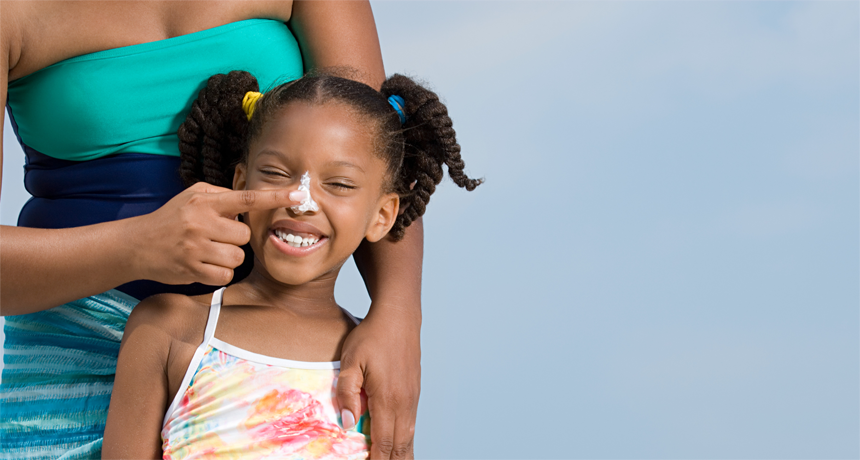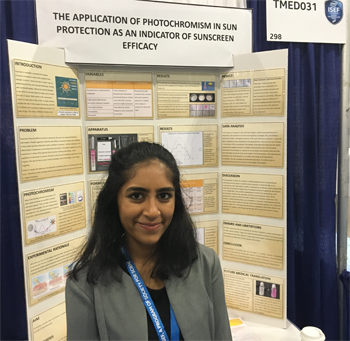This mix turns pink when sunscreen wears thin
A teen designs an indicator to signal when it’s time to reapply sunblock

Many people only apply sunscreen when they first go into the sun. A teen has invented a reminder to about when it's time to reapply and stay protected.
XiXinXing/istockphoto
LOS ANGELES, Calif. — Too much sun can lead to burns and blisters, even for those with dark skin or a tan. Beyond the pain, sunburns can increase the risk of skin cancer. Sunscreen can help, but it wears off — and people forget to reapply. With the power of chemistry, though, Farah Shaik, 16, has created a reapplication reminder. When sunscreen gets thin, this reminder turns pink to remind a person they need to slather on more sunblock.
The junior at Star College Girls’ High School in Durban, South Africa presented her new product here at the Intel International Science and Engineering Fair (ISEF). Created by Society for Science & the Public and sponsored by Intel, the yearly fair brings together high school students from around the world to show off their research projects. This year, nearly 1,800 students from more than 75 countries attended, competing for individual prizes worth up to $75,000. (The Society also publishes Science News for Students and this blog.)
“In South Africa we have a lot of sunlight. Most of the year is spent with the sunshine, so my friends and I spend a lot of time outside and we need to protect ourselves,” Farah says. “Sunscreen is the most effective way to do that.” Sunscreen is meant to protect skin from ultraviolet — or UV — light from the sun. We can’t see this light with our eyes. But the light can burn the skin if it’s exposed for too long. Sunscreen provides only a temporary shield, and those who forget to reapply can easily become burned.

After one too many burns, Farah decided to find something that would let her know when she needed to put on more sunscreen. She was inspired by an old arts and crafts project. Her father had bought her some photochromic beads — plastic beads that are white indoors but turn vivid colors in the sun. A photochromic chemical changes shape when it absorbs certain types of light. For some chemicals, that shape change alters an object’s color. A powder or bead that is white indoors can turn vivid blue, pink or yellow in the sun.
“I thought about what the beads contained, and I realized they contained a photochromic pigment,” Farah says. She thought that the pigment, or something like it, might make a good indicator for when it was time to reapply sunscreen. “It made sense because [the beads] changed color in response to UV light,” she notes.
Farah bought a small amount of a photochromic chemical called spiropyran. It turns bright pink in UV light. But she needed a way to apply the powder to the skin. She consulted with dermatologists — doctors who study the skin — as she developed a mix of chemicals that would let her easily apply the spiropyran. The doctors helped to ensure the chemicals she was using would be safe. In her kitchen, the teen mixed the powder with water, glycerin (found in bath products such as soap or lotion) and a few other chemicals to make a foam.
After making mixtures of 2.5 percent, 5 percent and 10 percent spiropyran, the teen began her tests. First, she put the solutions in full sunlight to see how long it took for their color to change. Farah also tested the chemical mixes under different types of light: UV light from a lamp, infrared light (another type of light we can’t see) and indoor fluorescent lights.
Only the UV light and sunlight made the mixtures turn pink, and the 10 percent solution was the brightest, the teen found. Coating the mixture with sunblock, though, effectively stopped the color change. When the sunblock wore off, the chemical went from zero to pink in about 30 seconds. “It’s a really quick change, which is good,” Farah says. “When the sunscreen wears off, you want to know immediately. You don’t want there to be any delay.”
Some companies sell photochromic chemicals in stickers. The idea is the same as Farah’s. Users can put the sticker on their skin and cover it with sunblock. When the sticker’s colors glow bright, it’s time to put on some more sunscreen.
Farah sees her product as something similar that people would apply before they put on their sunscreen. But they could be more creative than simply applying a sticker. “If it was in a sort of roller bottle, a person could apply a small pattern anywhere on their body,” she says. “When they put sunscreen on they would cover that area as well.” At first, the pattern would be protected from UV light by the sunscreen. But when the color re-appears, it would be time to reapply.
Drawing little patterns that appear later like magic might be a fun way to get kids into sun protection, the teen notes. Photochromic compounds come in many colors, and so the patterns people draw could become works of art, all in the name of sunburn prevention. “It’s basically drawing on yourself,” Farah says. “But it’s also helpful.”
Follow Eureka! Lab on Twitter







